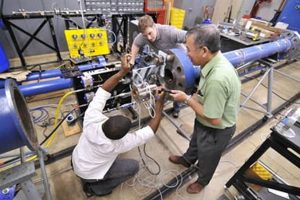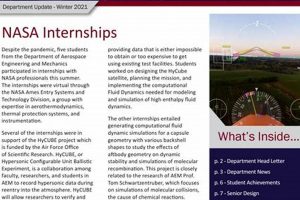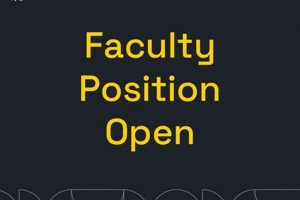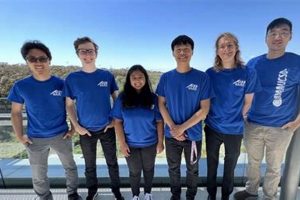The discipline at Purdue University focuses on designing, developing, and testing aircraft, spacecraft, and related systems. It encompasses a broad range of specializations, from aerodynamics and propulsion to structures and controls. Graduates often pursue careers in the aerospace industry, government research labs, or related engineering fields.
The program’s significance stems from its contribution to advancements in air and space travel, national defense, and scientific discovery. Its historical context involves decades of research and development, shaping modern aerospace technologies and educating leaders in the field. The academic rigor and practical training provided by the institution prepare students for the complex challenges inherent in aerospace innovation.
This article will delve into specific aspects of the Purdue University program, including its curriculum, research opportunities, faculty expertise, and notable alumni. The following sections will provide a detailed overview of what makes this institution a prominent center for aerospace education and research.
The subsequent advice is designed to aid prospective and current students in maximizing their experience within the aerospace engineering program at Purdue University. These tips are structured to promote academic success, professional development, and engagement within the field.
Tip 1: Prioritize Fundamental Coursework. A solid foundation in mathematics, physics, and introductory engineering courses is crucial. Mastery of these subjects provides the necessary tools for advanced studies in aerodynamics, propulsion, and structures.
Tip 2: Engage in Research Opportunities. Actively seek involvement in research projects with faculty. This provides hands-on experience, enhances technical skills, and strengthens candidacy for future academic or industry positions. Investigate opportunities within the Zucrow Labs or similar facilities.
Tip 3: Participate in Design-Build-Test Projects. Joining teams such as the Purdue Space Program or the AIAA Design/Build/Fly team offers practical experience in the engineering design process, from conceptualization to testing. This fosters teamwork and problem-solving abilities.
Tip 4: Cultivate Strong Communication Skills. Engineering requires clear and effective communication. Practice writing technical reports, presenting research findings, and participating in group discussions to refine these vital skills. Utilize the university’s writing resources.
Tip 5: Network with Industry Professionals. Attend career fairs, industry seminars, and guest lectures to connect with professionals in the aerospace sector. Building a professional network expands career opportunities and provides valuable insights into industry trends.
Tip 6: Utilize University Resources. Take advantage of the academic advising, tutoring services, and career counseling provided by Purdue University. These resources are designed to support student success and professional development.
Tip 7: Maintain a Strong GPA. A competitive grade point average is essential for securing internships, research positions, and future employment opportunities. Consistently strive for academic excellence in all coursework.
Tip 8: Consider a Specialization. The field offers opportunities to concentrate on specific areas, such as propulsion or astrodynamics. Early identification of a sub-discipline enables focused learning and preparation for a career in that area.
Adhering to these guidelines will contribute to a more rewarding and successful academic journey within the aerospace engineering program. The combination of rigorous coursework, hands-on experience, and professional development prepares graduates for leadership roles in the aerospace industry and related fields.
The subsequent sections will further explore the specific curriculum, faculty expertise, and research areas that define the Purdue University aerospace engineering experience.
1. Renowned Faculty
The reputation of aerospace engineering at Purdue University is intrinsically linked to the caliber of its faculty. These individuals, recognized experts in their respective fields, contribute directly to the program’s academic rigor, research productivity, and overall standing. Their presence attracts high-achieving students, facilitates cutting-edge research, and fosters a culture of innovation. The faculty’s expertise shapes the curriculum, ensuring that students receive instruction grounded in both fundamental principles and the latest advancements in the field. For instance, professors specializing in hypersonics directly influence the development of courses and research initiatives focused on high-speed flight, allowing students to engage with real-world challenges.
The influence of renowned faculty extends beyond the classroom. Their research endeavors, often funded by government agencies and industry partners, provide students with opportunities to participate in impactful projects. These hands-on experiences are invaluable for developing practical skills and building a professional network. Moreover, the faculty’s connections within the aerospace industry facilitate internships and employment opportunities for graduates. The mentorship provided by these experts is crucial for guiding students’ career paths and fostering the next generation of aerospace leaders. The faculty actively publish, present, and engage in leadership roles within professional organizations, further enhancing the department’s national and international visibility.
In summary, the presence of renowned faculty is a critical component of the high-quality aerospace engineering program. Their expertise, research contributions, and mentorship are instrumental in shaping the educational experience and preparing students for successful careers. Investing in and supporting faculty excellence remains essential for maintaining the program’s position as a leader in aerospace education and research. The challenges in attracting and retaining top-tier faculty are ongoing, requiring continuous efforts to provide competitive salaries, research resources, and a supportive academic environment.
2. Rigorous Curriculum
The demanding nature of the aerospace engineering field necessitates a rigorous curriculum, a defining characteristic of the Purdue University program. This curriculum is designed to equip students with the comprehensive knowledge and analytical skills required to address complex engineering challenges.
- Foundational Mathematics and Sciences
The curriculum emphasizes a strong foundation in mathematics, physics, and chemistry. Courses such as differential equations, linear algebra, and advanced calculus provide the mathematical tools necessary for modeling and analyzing aerospace systems. Physics courses cover mechanics, thermodynamics, and electromagnetism, providing a fundamental understanding of the physical principles governing flight and space travel. These subjects are not merely theoretical; they are directly applied to aerospace engineering problems, fostering analytical and problem-solving skills.
- Core Aerospace Engineering Disciplines
Beyond the fundamentals, the curriculum delves into core aerospace engineering disciplines, including aerodynamics, propulsion, structures, and control systems. Aerodynamics courses explore the behavior of airflows around aircraft and spacecraft, while propulsion courses cover the design and analysis of rocket engines and gas turbines. Structures courses focus on the mechanical behavior of aerospace vehicles, ensuring their structural integrity under extreme conditions. Control systems courses teach students how to design and implement systems that control the motion and stability of aircraft and spacecraft. Each of these disciplines involves a combination of theoretical coursework, computational simulations, and hands-on laboratory experiences.
- Design and Synthesis Experiences
A crucial component of the curriculum is the integration of design and synthesis experiences. Students participate in projects that require them to apply their knowledge to design, build, and test aerospace systems. These projects often involve teamwork, communication, and project management skills, preparing students for the collaborative nature of engineering practice. Capstone design courses provide a culminating experience where students work on complex design projects, often in collaboration with industry partners, resulting in real-world applications of engineering principles.
- Specialization and Electives
While providing a strong foundation in core disciplines, the curriculum also allows students to specialize in areas of interest. Elective courses enable students to delve deeper into specific topics, such as astrodynamics, space systems engineering, or computational fluid dynamics. These electives provide opportunities for students to tailor their education to their career aspirations and research interests, fostering expertise in niche areas of aerospace engineering.
The integration of these facets within the aerospace engineering curriculum at Purdue University underscores its commitment to providing a comprehensive and challenging educational experience. This rigorous approach ensures that graduates are well-prepared to contribute to the advancement of aerospace technology and address the evolving challenges of the field. The constant refinement of this curriculum, in response to technological advancements and industry needs, further emphasizes the program’s dedication to excellence.
3. Zucrow Labs
Zucrow Laboratories, a constituent of Purdue University’s aerospace engineering program, is a globally recognized center for propulsion research. Its facilities and expertise are integral to the program’s practical training and cutting-edge research initiatives.
- Advanced Propulsion Research
Zucrow Labs facilitates research into various propulsion systems, including rocket engines, gas turbines, and advanced concepts like hypersonic propulsion. This directly supports aerospace engineering students by providing them with opportunities to participate in experiments, analyze data, and contribute to advancements in propulsion technology. These research projects frequently result in publications and presentations at academic conferences.
- Hands-on Experience and Training
The labs offer students hands-on experience in designing, building, and testing propulsion systems. This practical training complements theoretical coursework, bridging the gap between classroom learning and real-world engineering challenges. Students gain proficiency in using sophisticated equipment and instrumentation, enhancing their technical skills and preparing them for careers in the aerospace industry.
- Industry Collaboration and Partnerships
Zucrow Labs maintains strong partnerships with aerospace companies and government agencies. These collaborations provide access to funding, resources, and expertise, enabling students to work on projects of direct relevance to industry needs. This collaboration strengthens the program’s ties to the aerospace sector, enhancing career opportunities for graduates.
- State-of-the-Art Facilities
The laboratories possess state-of-the-art facilities for propulsion research, including test cells, wind tunnels, and computational resources. These facilities enable researchers and students to conduct experiments and simulations under a wide range of conditions, accelerating the development of new propulsion technologies. The availability of such advanced resources is a significant advantage for aerospace engineering students at Purdue.
The activities within Zucrow Laboratories are central to the applied aspects of the aerospace engineering curriculum. The research and training opportunities provided by the labs contribute significantly to the program’s reputation and the career readiness of its graduates. The continuous investment in facilities and partnerships ensures that Zucrow Labs remains a vital component of aerospace engineering education at Purdue University.
4. Research Strengths
Research constitutes a cornerstone of aerospace engineering at Purdue University, driving innovation and contributing to advancements across various disciplines. The university’s commitment to research excellence directly enhances the educational experience for students and strengthens its position as a leading institution in the field.
- Hypersonics and High-Speed Flight
Purdue exhibits substantial research capabilities in hypersonics, addressing challenges related to high-speed flight and reentry vehicles. This includes the development of advanced materials, propulsion systems, and aerodynamic designs capable of withstanding extreme temperatures and pressures. The university’s hypersonics expertise aligns with national priorities in defense and space exploration, leading to significant research funding and collaborative projects with government agencies and industry partners.
- Advanced Propulsion Systems
Research in propulsion systems encompasses a wide range of technologies, from traditional rocket engines to advanced concepts like scramjets and electric propulsion. This includes work on improving engine efficiency, reducing emissions, and developing novel propulsion methods for deep-space missions. The Zucrow Laboratories, a dedicated propulsion research facility, provides students and faculty with state-of-the-art resources for conducting experiments and simulations.
- Autonomous Systems and Robotics
Autonomous systems and robotics represent a growing area of research, focusing on the development of intelligent systems for aerospace applications. This includes research on autonomous aircraft, unmanned aerial vehicles (UAVs), and robotics for space exploration. The university’s expertise in artificial intelligence, machine learning, and control systems contributes to the advancement of autonomous technologies with applications ranging from surveillance and reconnaissance to planetary exploration and resource utilization.
- Space Systems Engineering
Space systems engineering research addresses the challenges of designing, building, and operating spacecraft and satellites. This includes research on satellite communication, remote sensing, and space situational awareness. Purdue’s faculty and students are involved in projects ranging from CubeSat development to the design of large-scale space telescopes, contributing to advancements in space-based technologies and exploration initiatives.
These research strengths are not isolated endeavors but rather interconnected components of a broader ecosystem within Purdue’s aerospace engineering program. The research conducted by faculty and students directly informs the curriculum, providing students with access to the latest knowledge and technologies. Moreover, research opportunities provide students with valuable hands-on experience, preparing them for leadership roles in the aerospace industry and beyond. The ongoing investment in research infrastructure and faculty expertise ensures that Purdue remains at the forefront of aerospace innovation.
5. Industry Connections
The strength of the aerospace engineering program at Purdue University is significantly amplified by its robust industry connections. These connections are not merely superficial relationships; they are integral to the program’s ability to provide students with relevant, cutting-edge training and facilitate their transition into professional careers. A primary effect of these connections is the alignment of the curriculum with industry needs, ensuring that graduates possess the skills and knowledge most sought after by employers. For example, partnerships with companies like Boeing, Lockheed Martin, and SpaceX directly influence the types of projects students undertake in capstone design courses, mirroring real-world engineering challenges.
Industry connections also manifest in the form of internships, co-op programs, and research collaborations. These opportunities provide students with invaluable hands-on experience, allowing them to apply theoretical knowledge in practical settings and gain a deeper understanding of industry practices. Furthermore, industry professionals often serve as guest lecturers, mentors, and advisors, sharing their expertise and providing insights into career paths and emerging trends. A concrete example is the participation of industry representatives in career fairs and networking events organized by the university, creating direct channels for students to explore employment possibilities. The presence of corporate-sponsored research projects on campus, often conducted in facilities like Zucrow Labs, further strengthens the link between academic inquiry and industrial innovation.
In conclusion, the strategic cultivation of industry connections is a critical component of aerospace engineering education. It enriches the curriculum, provides practical training opportunities, and facilitates career placement for graduates. The ongoing challenge lies in maintaining and expanding these relationships in a rapidly evolving technological landscape. The programs success in this area directly contributes to its reputation and the long-term success of its alumni, solidifying its position as a leader in the field. The importance of these connections cannot be overstated, as they represent a vital bridge between academic learning and the practical application of engineering principles in the aerospace industry.
6. Notable Alumni
The achievements of alumni from Purdue University’s aerospace engineering program serve as a testament to the program’s effectiveness in preparing graduates for leadership roles in industry, government, and academia. Their accomplishments reflect the quality of education and the lasting impact of the program on the aerospace field.
- Leadership in Aerospace Corporations
Graduates have ascended to executive positions within major aerospace corporations, guiding strategic direction and technological innovation. These individuals often oversee the development of aircraft, spacecraft, and related systems, influencing the trajectory of the aerospace industry. Examples include CEOs and CTOs of prominent companies, demonstrating the program’s capacity to produce visionary leaders.
- Contributions to Space Exploration
Alumni have played pivotal roles in space exploration efforts, contributing to NASA missions and private space ventures. Their expertise spans areas such as mission design, spacecraft engineering, and astronautics. Participation in landmark space missions, such as the Apollo program or current Mars exploration initiatives, highlights the program’s influence on the advancement of space technology.
- Advancements in Aviation Technology
Graduates have significantly advanced aviation technology through research, development, and engineering innovation. Their contributions encompass areas such as aerodynamics, propulsion, and aircraft design, leading to improved performance, efficiency, and safety. Developments in commercial aviation, military aircraft, and unmanned aerial systems demonstrate the program’s impact on the evolution of flight technology.
- Scholarly Contributions and Academic Leadership
Alumni have established themselves as leading scholars and educators in aerospace engineering, contributing to the body of knowledge and shaping future generations of engineers. Their research contributions often lead to publications in prestigious journals and presentations at international conferences. Academic leadership roles at universities and research institutions further underscore the program’s capacity to foster intellectual growth and scholarly achievement.
The collective accomplishments of Purdue’s aerospace engineering alumni validate the program’s commitment to excellence and its enduring legacy in the aerospace field. Their contributions across diverse sectors showcase the program’s effectiveness in cultivating innovative thinkers, skilled engineers, and transformative leaders. The continued success of its alumni reinforces the program’s reputation as a premier institution for aerospace education and research.
7. Future Trajectory
The future trajectory of aerospace engineering is inextricably linked to the training and research conducted at institutions like Purdue University. Emerging trends and technological advancements will shape the curriculum, research focus, and career paths of future aerospace engineers graduating from the program.
- Focus on Sustainable Aviation
Increasing environmental concerns necessitate a shift towards sustainable aviation technologies. The program’s future trajectory will likely involve increased emphasis on alternative fuels, electric propulsion, and lightweight materials to reduce the environmental impact of air travel. Research into biofuels, battery technology, and advanced composite materials will become increasingly important for Purdue’s aerospace engineering students.
- Integration of Artificial Intelligence and Automation
Artificial intelligence (AI) and automation are poised to revolutionize aerospace engineering, impacting areas such as aircraft design, flight control, and air traffic management. The program’s curriculum will need to incorporate AI and machine learning principles to equip students with the skills to develop intelligent aerospace systems. Research into autonomous aircraft, predictive maintenance, and AI-powered flight control systems will gain prominence.
- Exploration of Space Commercialization
The commercialization of space is creating new opportunities and challenges for aerospace engineers. The program’s future trajectory will involve increased emphasis on space systems engineering, satellite technology, and space resource utilization. Research into low-cost access to space, in-space manufacturing, and asteroid mining will become increasingly relevant for Purdue’s aerospace engineering graduates.
- Advancement of Hypersonic Technologies
Hypersonic flight represents a frontier in aerospace engineering, with applications ranging from high-speed transportation to national defense. The program’s research efforts will likely focus on developing advanced propulsion systems, materials, and aerodynamic designs for hypersonic vehicles. Collaboration with government agencies and industry partners will be crucial for advancing hypersonic technologies and preparing students for careers in this emerging field.
These future trajectories require continuous adaptation within the academic framework. By incorporating these emerging trends into its curriculum and research initiatives, Purdue University’s aerospace engineering program aims to equip its graduates with the knowledge and skills necessary to lead the future of the aerospace industry. This proactive approach ensures the program remains at the forefront of aerospace innovation.
Frequently Asked Questions
This section addresses common inquiries regarding the aerospace engineering program at Purdue University, providing concise and factual responses to assist prospective students and interested parties.
Question 1: What distinguishes the aerospace engineering program at Purdue University from other similar programs?
The program’s strengths include its renowned faculty, rigorous curriculum, state-of-the-art facilities like Zucrow Labs, strong industry connections, and notable alumni. These factors combine to provide a comprehensive and impactful educational experience.
Question 2: What specific research areas are emphasized within the aerospace engineering program?
Key research areas encompass hypersonics, advanced propulsion systems, autonomous systems and robotics, and space systems engineering. These areas align with national priorities and offer students opportunities to engage in cutting-edge research.
Question 3: What career opportunities are available to graduates of the program?
Graduates pursue careers in the aerospace industry, government research labs, and related engineering fields. Common roles include design engineers, research scientists, project managers, and consultants.
Question 4: What academic preparation is recommended for students interested in applying to the aerospace engineering program?
A strong foundation in mathematics, physics, and introductory engineering courses is essential. High school students should focus on these subjects to prepare for the rigor of the program.
Question 5: Does the aerospace engineering program offer opportunities for hands-on experience?
Yes, the program incorporates design-build-test projects, research opportunities, and laboratory experiences. These activities provide students with practical skills and prepare them for real-world engineering challenges.
Question 6: How does the aerospace engineering program facilitate connections with industry professionals?
The program organizes career fairs, industry seminars, and guest lectures. These events provide opportunities for students to network with professionals from aerospace companies and government agencies.
These answers provide a concise overview of key aspects of the aerospace engineering program. Further information can be found on the Purdue University website or by contacting the department directly.
The following section concludes the article, summarizing the key points and highlighting the program’s significance.
Conclusion
This article has explored various facets of aerospace engineering at Purdue University, emphasizing its rigorous curriculum, renowned faculty, state-of-the-art facilities, and strong industry connections. The program’s commitment to research excellence, particularly in areas such as hypersonics and autonomous systems, contributes significantly to the advancement of aerospace technology. The accomplishments of its notable alumni demonstrate the program’s effectiveness in preparing graduates for leadership roles across diverse sectors.
Aerospace engineering at Purdue University remains a vital force in shaping the future of air and space travel. Its continued investment in education, research, and industry partnerships ensures its position as a leading institution. Prospective students are encouraged to further explore the program’s offerings and consider its potential to launch a successful career in this challenging and rewarding field.







